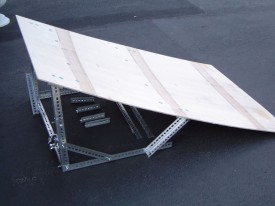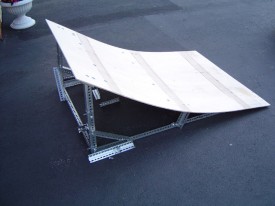Project: Portable Adjustable Ramp
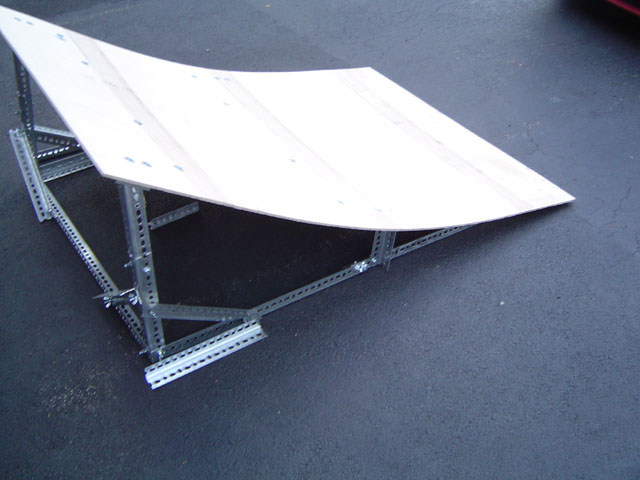
(We have a newer ramp design, which you can read about at this link.)
When we set out to build a ramp, we had a few restrictions:
- The ramp has to be portable (has to fit in our trucks).
- The ramp has to be adjustable (height and ramp curve).
- The ramp has to be sturdy.
- Time to bash: Can be built in a weekend.
Our Materials
| 4′ by 5′ plyfloor underlayment | $ 9.89 |
| 6′ plated slotted angle 1-1/2″ by 1-1/2″ (14Gauge) – 5 (@ $6.98 each) | $34.90 |
| 5/16″ flat washers (82 pack) | $ 1.18 |
| 5/16″ wing nuts – 5 packages of 5 (@ $0.79 each) | $ 3.95 |
| 5/16″x3/4″ hex bolts – 5 packages of 5 (@ $1.18 each) | $ 5.90 |
| 1/4″x1″ Flat Head Stove Bolts with nuts 4 packages of 4 (@ $0.82 each) | $3.28 |
| Total | $59.10 |
The ply-floor underlay is basically 1/4″ plywood. One of our building restrictions was that the ramp needed to fit in our truck. If you have more space available, you can increase the length for a longer run up or higher ramp.
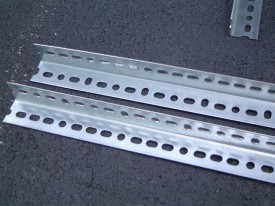 The plated slotted angles are strong lengths of steel with holes across it. They are available in several different thicknesses and lengths. You may want to shop around at local hardware stores to make sure you are getting a good price on these. We found one hardware store in our area was considerably cheaper than another hardware store with the same quality materials. We chose thicker steel for improved strength (and weight). The thicker steel was around $0.50 more expensive per 6′ piece.
The plated slotted angles are strong lengths of steel with holes across it. They are available in several different thicknesses and lengths. You may want to shop around at local hardware stores to make sure you are getting a good price on these. We found one hardware store in our area was considerably cheaper than another hardware store with the same quality materials. We chose thicker steel for improved strength (and weight). The thicker steel was around $0.50 more expensive per 6′ piece.
Preparing Materials
The only difficult part of building this ramp is cutting the metal. We used a sawzall with a fine toothed metal-cutting blade. We found that a blade with larger/longer teeth bounces around more and makes cutting more difficult. Even with a good blade, the metal can be difficult to cut, so please use care and wear safety equipment.
We cut down the plywood to 42″ by 60″ to better fit in our truck.
The metal was cut as follows:
- (3) – 36″ pieces
- (10) – 12″ pieces
- (4) – 24″ pieces
- (4) – 6″ pieces
- (4) – 3″ pieces
We need to attach two of our 36″ slotted angles to our wood to provide support for the ramp. We also need to attach our 3″ pieces so we can attach the wood to our frame. Set each piece in place and mark the wood at each hole that will be bolted on. Remove the metal pieces and drill holes for each of the Stove Bolts. Insert each bolt with a washer in the wood and through the metal piece.
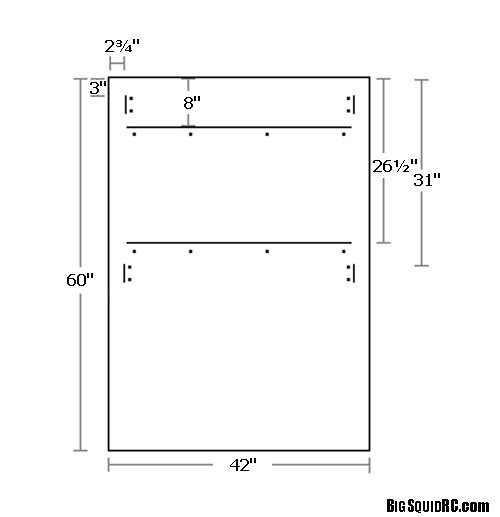
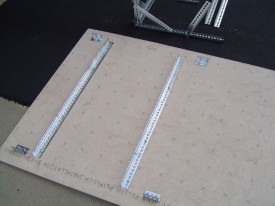 Now that our board is ready, it is time to assemble the frame.
Now that our board is ready, it is time to assemble the frame.
Our frame is designed to be highly adjustable. The parts are held together entirely with our hex bolts and wing nuts, so we can assemble and make any adjustments at whatever location we decide to use it.
The main part of our frame is always assembled the same way. Start with two 24″ pieces of metal on the ground 3 feet apart and facing each other. Set the 36″ piece above these two. Add a 12″ piece standing up at each corner and attach with hex bolts and wing nuts.
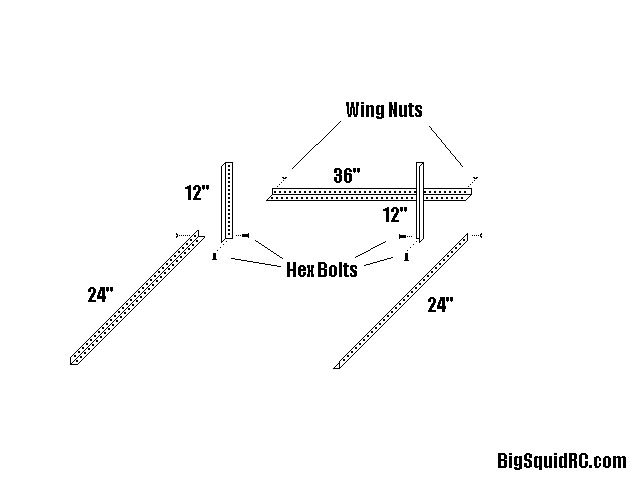
Be sure to insert the bolts from inside of the frame towards the outside of the frame. This way, you should be able to attach the wing nuts without problems.
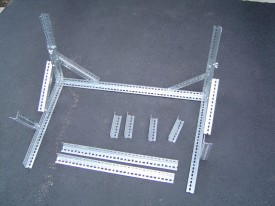 Attach two more 12″ pieces at angles to our vertical supports for additional strength. The metal we are using is strong, but it will twist easily without proper support. For a higher ramp, attach additional 24″ segments to the vertical supports. By overlapping the segments, we can adjust the ramp to any height we need.
Attach two more 12″ pieces at angles to our vertical supports for additional strength. The metal we are using is strong, but it will twist easily without proper support. For a higher ramp, attach additional 24″ segments to the vertical supports. By overlapping the segments, we can adjust the ramp to any height we need.
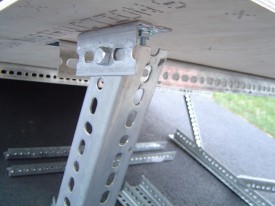 Now we can attach our board to our frame. Place the board so the connectors at the top of our board line up with the top of our frame supports. Add a couple of bolts and wing nuts and we’re almost ready to go.
Now we can attach our board to our frame. Place the board so the connectors at the top of our board line up with the top of our frame supports. Add a couple of bolts and wing nuts and we’re almost ready to go.
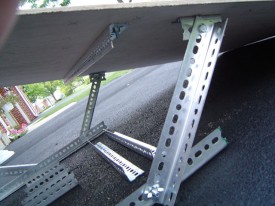 Now we just need to determine what the curve of our ramp will be. Let’s start with a straight ramp for distance jumping. Start with a 12″ piece of our slotted angle and attach it to one of the connectors in the middle of the ramp. Hold the ramp straight and line up the metal with a hole on our side support. If the metal is too short, attach a 6″ piece to extend it. If it is too long, replace it with a 6″ piece. Attach the metal with another bolt and wing nut. Repeat the same way on the other side and we are ready to BASH!
Now we just need to determine what the curve of our ramp will be. Let’s start with a straight ramp for distance jumping. Start with a 12″ piece of our slotted angle and attach it to one of the connectors in the middle of the ramp. Hold the ramp straight and line up the metal with a hole on our side support. If the metal is too short, attach a 6″ piece to extend it. If it is too long, replace it with a 6″ piece. Attach the metal with another bolt and wing nut. Repeat the same way on the other side and we are ready to BASH!
To get more curve in our ramp, we just need to adjust the length of our center supports. Using shorter supports will force the ramp to a steeper curve and give higher jumps. Keep in mind that it is not that difficult to break the wood this way. Also, if you make a steep curve, you may find your ramp lifting its frame off the ground in order to straighten out. To correct this, use some extensions on the side supports until they reach the underside of the wood. The frame should then be able to hold the curve.
While our ramp works well now, it is still pretty slippery. We are going to try covering it with a rug we saw at our local hardware store. It is a black rug with rubber backing that we are going to staple on upside-down. This should give us better traction and cover the bolt heads. We will let you know how it works for us.
IMPORTANT NOTE: We built this ramp for use with RC cars only. While we have attempted to make our ramp able to hold up to a lot of forces, this ramp is not designed to hold a person’s weight. Don’t try using bikes or skateboards on this ramp. Also, a flying RC car is a dangerous thing. Even good drivers can hit a ramp sideways and send their car in an unwanted direction. Break your car, not your head.

